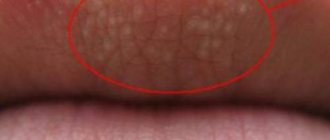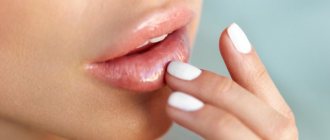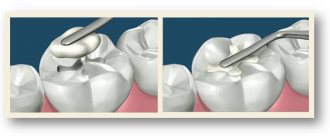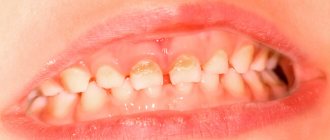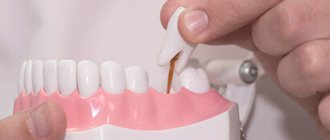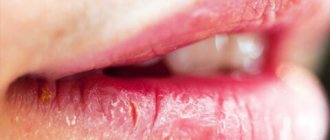Seizures - symptoms and causes of manifestation.
Seizures appear in the corners of the lips in the form of small inflamed areas. The location of the jam in the corners of the lips prevents the expansion of the mouth, causing pain when laughing, smiling, or eating. In addition, this is a striking aesthetic defect. Sometimes bumps on the lips are not particularly noticeable, but cause a lot of inconvenience to their owners.
Usually, seals appear on the lips during cold seasons. It is during this period that when saliva comes into contact with the skin in the folds, the inflammatory process begins. In the place where it originates, a forming crust is noticeable. The more movements a person makes with his mouth, the more inflamed the corner of his lips becomes.
The causes of sticking in the corners of the lips can be very different. The most common of these is vitamin B2 deficiency in the body. In this case, inflammation in the corners of the lips occurs due to the fact that the immune balance in the body is disturbed and it is more difficult for it to fight the infection even at the initial stage.
The causes of sticking in the corners of the lips are divided into three large groups:
- The first group includes bacterial sources. In this case, the main bacteria are streptococci. Their reproduction in the folds in the corners of the lips forms a favorable microflora for infection.
- The second group of reasons is fungal. Candidiasis infection affects the corner of the lips from the outside and inside.
- The last group includes viral causes of sticking in the corners of the lips. The main viral source of infection is the herpes virus, which, when it appears in the corners of the lips, looks like a jam.
The main sources of weakening of the body and the manifestation of sticking in the corners of the lips is inattention to one’s health, namely:
- hypothermia or overheating of the body;
- long-term increase in body temperature;
- poor oral and lip hygiene;
- direct physical contact with a sick person;
- colds and respiratory diseases;
- long-term exacerbation of chronic diseases.
In all these cases, the body's immune system weakens and cannot fight the multiplying harmful microorganisms, which manifest themselves as sticking on the lips.
In addition to the internal reasons for the manifestation of this type of disease, lip jamming can manifest itself as an independent disease in the corners of the lips.
Types of pathology and clinical manifestations
Seizures are represented by several main options, represented by:
Exfoliative form
The pathology is limited to inflammation of the red lip border with peeling, and is more often recorded in women. The source of cheilitis formation is considered to be:
- depression;
- anxiety;
- activation of the thyroid gland;
- disruptions in immunity;
- hereditary predisposition.
The disease takes two forms:
- dry – with increased dryness, burning and scales on the lips, lasts for years, has no tendency to self-heal;
- exudative - determined by pain, swelling, abundant crusts.
In the latter case, patients find it difficult to speak or eat.
The exudative form of exfoliative cheilitis is characterized by severe pain,
Atopic
The causes of the formation of diffuse neurodermatitis are:
- cosmetics and medicines;
- food products;
- heredity with allergies;
- bacteria.
The deviation is manifested by itching, hyperemia, exfoliation of skin particles and damage to the corners of the mouth. After completion of the acute phase, peeling with dryness develops, causing cracks.
Glandular
Cheilitis develops against the background of a congenital or acquired anomaly of the salivary gland, and is activated by the penetration of infectious agents. Zaeda occurs in people over 30 years of age; the upper lip is affected less frequently than the lower lip by a factor of 2. The pathology begins with dryness, then erosions, cracks, and weeping form.
Candida
Fungal infection occurs with reduced immunity and prolonged antibiotic therapy. Symptoms include the appearance of dry patches on the corners of the mouth, films with a grayish or whitish tint, the removal of which leads to bleeding and thinning of the surface of the lips. Burning and tightness accompany the opening of the mouth; licking worsens the pain. Lack of therapy causes transition to a chronic disease with frequent relapses.
Contact allergic
The deviation is provoked by the chemical composition of dentures, cosmetics, contact with writing instruments, etc. The jam leads to irritation, swelling, and hyperemia. With inflammation, rashes form, the opening of which ends in erosions with cracks.
Meteorological
The disease is registered in men from 20 to 60 years old and develops with increased sensitivity to wind, frost, sun, and radiation. The exudative form of cheilitis causes itching, burning sensation, crusts, erosive spots, small blisters, and pain. Dry - dryness, discomfort. Precancerous forms may appear with a constant source of irritation, including dust, humidity, and smoking.
Hypovitaminosis
It is formed due to a deficiency of B vitamins and is manifested by burning and dryness on the mucous surfaces of the lips, mouth, and tongue. After the formation of small scales, vertical bleeding cracks, inflammation and an increase in the volume of the tongue occur.
Macrocheilitis
The disease is combined with folded tongue syndrome and neuritis of the facial nerve. Appears under the influence of infections and allergens, with genetic predisposition. Patients experience an increase in lip size and swelling of nearby facial tissues. In the affected area, the dermis has a bluish-pinkish tint. The face tilts to the healthy side, the nasolabial fold is smoothed out.
Only a doctor can clarify the correct type of jam after a diagnostic examination.
Diagnosis
During the examination, the clinic performs a full examination of the patient with further analysis and laboratory tests. This stage is necessary, first of all, because eliminating external signs of jamming in the corners of the lips will not lead to success. The reason lies in the body itself, and in order to get rid of the jam, you need to start treating from the very center of the disease.
The main symptoms of a seizure in the corner of the mouth are:
- constant itching in the corners where inflammation begins;
- sharp pain when opening the mouth wide; if the inflammation is severe, then it is felt even when the opening is not wide;
- redness and the appearance of a small wound in the area where the jam appears;
- deep cracks in the corners of the lips.
A careful examination is the key to good health and high-quality elimination of the disease. To correctly characterize the nature of the jam, a scraping is taken from the inflamed area of skin near the lips, which is studied in the laboratory. During the research, all concerns about the occurrence of dangerous diseases, such as syphilis, are eliminated. Next, an analysis is carried out on the nature of the occurrence of jams in the corners of the lips. After laboratory tests, the doctor identifies all the factors that contributed to the weakening of the body and the occurrence of the problem. The treatment is prescribed in combination - depending on the complexity of the problem, the patient will have to take several courses of drugs.
Side effects
Very rarely, when using the drug Triderm®, the following are observed: burning sensation, erythema, exudation, pigmentation disorders and itching.
Caused by local corticosteroids (especially when using occlusive dressings): burning sensation, itching, dry skin, folliculitis, hypertrichosis, acne, hypopigmentation, perioral dermatitis, allergic contact dermatitis, skin maceration, development of secondary infection, skin atrophy, stretch marks, prickly heat.
Caused by clotrimazole: erythema, tingling sensation, blistering, peeling, local swelling, itching, urticaria, skin irritation.
Caused by gentamicin: transient skin irritation (erythema, itching), usually not requiring discontinuation of treatment.
How to treat jams in the corners of the lips
In addition to a set of drugs that will restore the body’s immunity and eliminate the main causes of sticking on the lips, the patient needs to use special ointments that will moisturize the crust that has formed in the corner of the lips, soften movements and promote rapid regeneration of inflamed skin.
In addition to medications and ointments, the patient is prescribed a course of vitamins to generally strengthen the immune system and the body. A strong body is less susceptible to inflammatory processes and the penetration of viruses. Once they enter the body, viruses can cause enough harm to eventually cause not only seizures, but also other diseases.
In addition to drug treatment, the patient is recommended to make an effort and get rid of the habit of constantly licking his lips. This prevents the wound from being in a damp state, which only multiplies the number of bacteria that provoke inflammation. Also, an equally important step is to follow a proper diet, excluding excess sweet, spicy and salty foods. All these products provoke the growth of bacteria and prevent the rapid healing of the inflamed skin area.
special instructions
Cannot be used in ophthalmic practice.
Prolonged topical use of antibiotics can sometimes lead to the growth of resistant microflora. In this case, as well as if irritation, sensitization or superinfection develops while using the drug Triderm®, treatment should be interrupted and appropriate therapy should be prescribed. Cross-allergic reactions with aminoglycoside antibiotics have been observed.
Any side effects that occur with the use of systemic corticosteroids, including suppression of the function of the adrenal cortex, can also be observed with local use of corticosteroids, especially in children.
Systemic absorption of GCS or gentamicin when applied topically will be higher if treatment is carried out over large surfaces of the body or when using occlusive dressings. Avoid applying gentamicin to open wounds or broken skin. Appropriate precautions should be taken in such cases, especially when treating children.
It is recommended to discontinue the drug after long-term use gradually.
Use in pediatrics
Children from 2 years of age are prescribed only according to strict indications and under medical supervision, because Systemic side effects associated with betamethasone may develop. When using the drug Triderm®, like many other topical corticosteroids on large surfaces and/or with an occlusive dressing, the function of the hypothalamic-pituitary-adrenal system may be suppressed, a decrease in the excretion of growth hormone, as well as an increase in ICP may be observed.
Impact on the ability to drive vehicles and operate machinery. No effect of Triderm® on the ability to drive vehicles or operate machinery has been identified.
Prevention
To prevent sticking in the corners of your lips, carefully monitor your oral and dental hygiene. Inflammation begins with an overabundance of microbes in the oral mucosa. Brushing your teeth daily and using special rinses is one of the many steps that can prevent clogging in the corners of your mouth.
An important step is the general strengthening of the body and immunity. Taking a course of vitamins is a good solution, but first you should consult a doctor and undergo all the necessary examinations to determine the correct combination of drugs.
This method of treatment concerns not only oral health. Every disease must be treated from the inside, eliminating the problem, because this is the only way to avoid relapse. Properly selected drug treatment helps eliminate internal problems in the body and thereby eliminates the main sources of inflammation.
An equally important factor that should be excluded is the habit of frequently licking and biting your lips. Seizures appear most often in those people who have these bad habits. The corners of the lips moistened with saliva become chapped on the street, which promotes the growth of bacteria in the damaged area of the skin. The jam becomes covered with a crust, since the inflamed area of the skin is located in a place where there are a lot of depressions and folds. A person cannot help but talk, and when talking, his lips open. Movement disturbs the inflamed area of the skin, and the wound heals much more difficult due to the fact that it is constantly in motion and the integrity of the crust is constantly broken.
Overdose
Symptoms: with long-term use of local corticosteroids in high doses, suppression of adrenal function with the development of secondary adrenal insufficiency and symptoms of hypercortisolism, including Cushing's syndrome, is possible. An overdose of clotrimazole when applied topically does not lead to the appearance of any symptoms. With a single overdose of gentamicin, the appearance of any symptoms is also not expected. Long-term treatment with gentamicin in high doses can lead to the growth of insensitive flora.
Treatment: symptomatic. Acute symptoms of hypercortisolism are usually reversible. If necessary, electrolyte imbalance is corrected. In case of chronic GCS toxicity, gradual withdrawal of GCS is recommended.
Dentists' advice: jams are easier to prevent
Most often, dentists say that it is easier to prevent oral health problems than to treat them later. Dental examinations and treatments are among the most expensive on the medical market, and not everyone has enough financial resources to afford a professional dentist in the event of a routine problem.
A single case of such a disease is overlooked, since the cause of its occurrence is banal weathering. But, if jams appear frequently and heal with difficulty and complications, a consultation with a dentist is necessary.
In order to avoid jams, dentists recommend daily use of special rinses for teeth and gums and daily brushing of teeth twice a day. All these rules help to keep the oral cavity not only in proper appearance, but also in a healthy condition.
Compound
| Ointment for external use | 1 g |
| active substances: | |
| betamethasone dipropionate | 0.643 mg |
| (equivalent to 0.5 mg betamethasone) | |
| clotrimazole | 10 mg |
| gentamicin (as gentamicin sulfate) | 1 mg (1000 IU) |
| excipients: liquid paraffin - 50 mg; soft white paraffin – qs up to 1 g |
| Cream for external use | 1 g |
| active substance: | |
| betamethasone dipropionate | 0.643 mg |
| (equivalent to 0.5 mg betamethasone) | |
| clotrimazole | 10 mg |
| gentamicin (as gentamicin sulfate) | 1 mg (1000 IU) |
| excipients: petroleum jelly - 150 mg; propylene glycol - 100 mg; cetostearyl alcohol - 72 mg; liquid paraffin - 60 mg; macrogol cetostearate - 22.5 mg; benzyl alcohol - 10 mg; sodium dihydrogen phosphate dihydrate - 2.995 mg; phosphoric acid - 0.03 mg; phosphoric acid or sodium hydroxide - until pH is established; purified water - qs up to 1 g |
